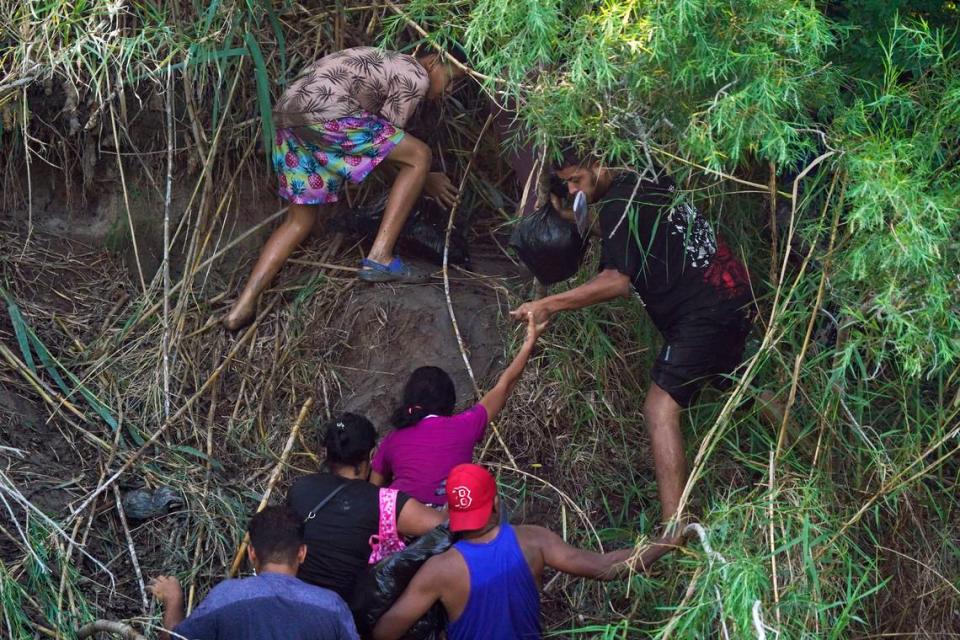New Biden rule will crack down on border arrivals as pandemic-era Title 42 comes to an end
- Oops!Something went wrong.Please try again later.
When the pandemic-era immigration rule known as Title 42 comes to an end Thursday night, a new regulation will make it harder for migrants who show up at the U.S.-Mexico border to seek political asylum in the United States, the Biden administration said Wednesday.
Asylum seekers showing up at the border without prior authorization will have to show proof they requested asylum in any of the countries they traveled through on their way to the border, and that the request was denied.
The controversial rule, which immigration advocates say mirrors a similar travel ban by the Trump administration, is among several new changes the Department of Homeland Security is rolling out as it prepares for the end of Title 42 at 11:59 pm. Thursday.
A public-health order used by President Donald Trump during the COVID-19 pandemic, Title 42 allows border agents to quickly expel asylum seekers at the U.S.-Mexico border. It is expiring along with other pandemic-era emergency policies.
Biden administration officials say that, unlike the Trump administration, they are presenting migrants with several new legal pathways to protection in the United States. Immigration advocates, however, disagree and note that the Trump transit asylum ban was ultimately struck down by federal judges in several courts, hinting that they may challenge the latest rule as well.

While welcoming the end of Title 42, advocates accuse the Biden administration of making it even more difficult for people fleeing violence and political persecution to seek protection in the U.S. during what experts all agree is an unprecedented time of global and hemispheric displacement. Many migrants making their way to the United States travel through several countries, some of them as far as Brazil.
On Wednesday, workers with the Haitian Bridge Alliance fanned out across the Mexican town of Reynosa, just across the border from McAllen, Texas, telling migrants not to listen to smugglers encouraging them to “run to the border” before Title 42 ends. If they do, they will be detained, expelled and possibly banned from entering the U.S. for at least five years, workers warned.
“They are so desperate and anyone can tell them that the border is open and they will believe it and try just in case it’s true,” Guerline Jozef, co-founder of the San Diego-based organization, told the Miami Herald from Mexico. “This is why it’s so very important that the messaging from the administration is clear and precise so people can understand it.”
Jozef said there are about 10,000 migrants in the town, and at least 6,000 of them are Haitians. Many of the migrants remain confused, wondering, for instance, if they will now be subject to the asylum rule, despite having spent up to a year in camps trying to get access to the United States.
The new U.S. policy is “telling people in transit to apply for asylum in countries where people are also fleeing from and seeking asylum,” said Jozef, who opposes the ban. “The U.S.-Mexico border is being pushed into South and Central America. That is the reality, and my fear is that they are putting those systems in place so people can avoid smugglers. Those are the very reasons why people will try to find alternative ways to make the journey and create a new ecosystem for human traffickers and smugglers.”
President Biden and Homeland Security Secretary Alejandro Mayorkas have come under fire from immigration advocates as well as Republican governors and lawmakers about the changing policies. While advocates have accused the administration of doing away with Title 42 just to replace it with asylum bans and tougher enforcement and detention policies, Republicans say the administration is sending the signal that the U.S.-Mexico border is open.

It has put the Democratic president in a political bind just as he launches his campaign for reelection in 2024, faced with a base that is dissatisfied with his approach to the border and a Republican opposition emboldened by a narrative that migrants are overrunning the border.
Biden officials argue that new, innovative policies — such as offering parole to Haitians, Venezuelans, Cubans and Nicaraguans, while cracking down on those who attempt to come to the U.S. unlawfully — shows they are delivering on tough border enforcement.
“We are going to continue to enforce U.S. immigration laws and people who attempt to come across illegally are not going to be able to stay, are going to be returned,” Homeland Security spokesperson Luis Miranda told the Herald. “This administration has done a significant amount of work to ensure there are lawful pathways, there are ways for people who need it to be able to come.”
A roughly 90% drop in arrivals at the southern border by nationals from Cuba, Haiti, Nicaragua and Venezuela between December and March, however, has done little to improve the president’s public standing among critics.
“The president has less power here than they would perhaps like to admit,” said Aaron Reichlin-Melnick, policy directory for the American Immigration Council. “Fundamentally, this is a problem that cannot be fixed without substantial investment from Congress. It’s been 27 years since we’ve made any major changes to our humanitarian protection system, and it’s been 33 years since we updated our legal immigration system – it predates the World Wide Web.”
During a Wednesday press conference, Mayorkas defended the administration’s approach and said that migration is a regional problem that requires a regional approach, which the administration is taking through various initiatives.
He acknowledged that the U.S. ‘s “broken immigration system” could be in for a difficult period ahead.
“Even after nearly two years of preparation we expect to see large numbers of encounters at our southern border in the days and weeks after May 11,” Mayorkas said. “We are already seeing high numbers of encounters in certain sectors.”
He touted the new legal pathways for migrants that the administration has put in place, including an asylum-appointment system that uses a smartphone app known as CBP One. He said anyone choosing not to use those legal paths will face bigger hurdles to getting protection in the United States.
He added that Congress is primarily to blame for failing to update the country’s immigration system for over two decades — or to sufficiently fund the agency ahead of a potential, predictable surge.

A majority of Republican voters consistently rank immigration among their top priorities when entering the ballot box, incentivizing some conservatives to keep immigration as a voting issue. And while fewer Democrats consider immigration when they vote, those that do, tend to favor broader pathways for asylum seekers.
The new asylum rule, still being finalized by the Department of Justice and expected to take effect after Thursday, presumes that anyone who shows up at the border without prior authorization is ineligible for asylum. Migrants can rebut that presumption in limited circumstances — for example, if they used the pathway or sought asylum in another country through which they had traveled and were denied.
“Forcing persecuted people to first seek protection in countries with no functioning asylum systems is as ludicrous as it is life-threatening,” said Lee Williams, chief programs officer at Lutheran Immigration and Refugee Service. “This ban is Title 42 in sheep’s clothing, and it will have a devastating impact on children and families already uprooted by unimaginable violence, persecution, poverty, and climate disaster.”
Williams said the administration is choosing to “defy decades of humanitarian protections enshrined in U.S. law and international agreements.” The Immigration and Nationality Act, Williams said, provides that people seeking protection may apply for asylum regardless of manner of entry, and does not require them to have first applied for protection in another country.
Victoria Ward, regional director for Save the Children in Latin America and the Caribbean, said by outsourcing asylum decisions to other countries in the region, children and families will face increased deportation from countries once they leave their homeland.
“While we welcome the potential for simpler asylum processing, some of the new measures in this policy could increase the dangers facing migrant children and their families. We also worry that more children will travel unaccompanied,” she said. “It is also possible that across the Americas we will see increases and xenophobia and discrimination against migrants and higher rates of sexual exploitation, violence from gangs, and organized traffickers.”
